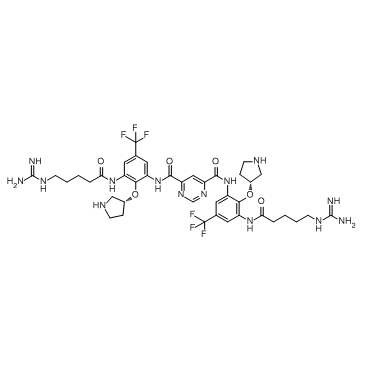| Description |
Brilacidin is a nonpeptidic anti-infective in a new class of defensin mimetics that is being developed for the treatment of eye infections.
|
| Related Catalog |
|
| In Vitro |
Both Staphylococcus aureus (SA) and Staphylococcus epidermidis (SE) have the lowest minimum inhibitory concentrations among the bacterial groups. The MIC90s to Brilacidin for Streptococcus pneumonia (SP), Streptococcus viridians (SV), Moraxella (MS), Haemophilus influenza (HI), Pseudomonas aeruginosa (PA), and Serratia marcescens (SM) are 4, 32, 256, 32, 16, and 128-fold higher, respectively, than SA and SE. Brilacidin has Gram-positive in vitro activity; topical Brilacidin 0.5% is minimally irritating; and Brilacidin 0.5% was equally efficacious as Vancomycin (VAN) in a methicillin-resistant S. aureus (MRSA) keratitis model when the corneal epithelium is removed. Brilacidin acts primarily on the bacterial cell membrane by depolarization. Brilacidin is more potent for Gram-positive bacteria (except SV) than Gram-negative bacteria[1].
|
| In Vivo |
Brilacidin demonstrates dose-dependent ocular toxicity after 7 topical instillations (every 30 min for 3 h) in the NZW rabbit ocular toxicity model. Brilacidin 1% is determined to be Mildly Irritating (23.0), Brilacidin 0.5% (6.5), and Brilacidin 0.25% (4.0) are determined to be Minimally Irritating, while Brilacidin 0.1% (2.0) and TBS (1.0) are determined to be Practically Nonirritating and 0.01% Brilacidin (0.5) is determined to be Nonirritating based on their Maximum mean total scores (MMTS) values[1].
|
| Cell Assay |
All susceptibility testing is performed by adding 90 μL of bacterial inoculum to 10 μL of 10× serial concentrations of Brilacidin into rows of a 96-well polypropylene plate. Each plate can test 8 bacterial isolates with each row containing a positive growth control and 11 serial dilutions. The diluent of Brilacidin contains 0.01% acetic acid and 0.2% bovine serum albumin. Polypropylene tubes, pipettes, and pipette tips are used to avoid binding of Brilacidin. A 1% stock of Brilacidin is diluted to 1,280 μg/mL and this is serially diluted 2-fold for 10 times to provide testing concentrations. PA and SM are tested starting at 128 μg/mL and ending at 1.25 μg/mL. All other bacteria are tested starting at 64 μg/mL and ending at 0.625 μg/mL. MICs are determined visually by locating the lowest concentration of Brilacidin that inhibits visible bacterial growth (pellet formation). The MICs are tabulated for each bacterial group and reported as MIC50, MIC90, and a range from the lowest to highest MIC[1].
|
| Animal Admin |
Rabbits[1] Ocular toxicity was evaluated with 5 concentrations (1%, 0.5%, 0.25%, 0.1%, and 0.01%) of Brilacidin, formulated in Tris-buffered saline (TBS) using the Draize scoring system in the NZW rabbit ocular irritation model. The Draize Scale grades for toxicity to: cornea (opacity-degree of density, area involved), iris, and conjunctiva (redness, chemosis, and discharge). Two rabbits are tested for each Brilacidin concentration and TBS (vehicle control). Rabbits are treated in both eyes with (37 μL) topical drops every 30 min for 3 h (7 total doses). Rabbits are evaluated in a masked fashion for ocular toxicity. Ocular toxicity is evaluated using the Draize scoring system after treatment on day 0 for acute toxicity and on day 4 post treatment for any delayed toxicity. Maximum mean total scores (MMTS) are calculated and eye irritation is classified.
|
| References |
[1]. Kowalski RP, et al. An Independent Evaluation of a Novel Peptide Mimetic, Brilacidin (PMX30063), for Ocular Anti-infective. J Ocul Pharmacol Ther. 2016 Jan-Feb;32(1):23-7.
|
